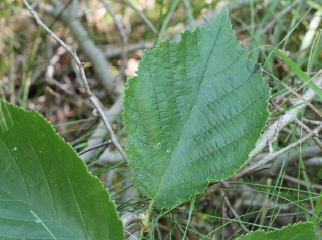Plant Selection at Ernest Road: Shrubs
American Hazelnut (Corylus americana)
Cultivated in the US since the late 1700s, the common name is derived from 'hazel', which is an old English name for filbert. Corylus comes from the Greek word 'korus' which means 'helmet', referring to the shape of the hard nut shells. The shrub produces a 1/2-inch brown nut that is enclosed in a hairy, leaf-like husk with ragged edges. The nuts are edible at maturity in the fall, typically from September to October. The nuts are typically produced on plants that are 2-3 years old and older. Nuts are similar in flavor to the European filbert, and may be roasted and eaten or ground into flour, but are also commonly left for the squirrels and birds.
American Hazelnut Overview
American Hazelnut Leaves
American Hazelnut Fruit
American Hazelnut Bark
Hearts A’busting (Euonymus americanus)
Also known as Strawberry Bush, Hearts A’busting is a low maintenance deciduous suckering shrub native to the southeastern and southern states. Its common name derives from the showy warty capsules that split open to reveal red-orange seeds in the fall. Spring flowers are small and non-showy but fall leaf color is a showy red. This species is commonly reduced to small vegetative sprouts by repeated deer browsing, and for that it is sometimes referred to as deer ice cream. Seeds are eaten by songbirds, wild turkeys and small mammals.
Hearts A’busting Overview
Hearts A’busting Leaves
Hearts A’busting Fruit
Hearts A’busting Flowers
Black Haw (Viburnum prunifolium)
Blackhaw is a large suckering native shrub or small tree that may grow 20 feet tall and nearly as wide. It provides 3 seasons of interest and is a high-value wildlife plant. The spring flowers are in large white cymes and the fall leaf color is in reds and purples. Berries mature to purplish-black and are eaten by both humans and birds. Viburnums set fruit better with more than one shrub for pollination. It is a host plant for Spring/Summer Azure butterflies. This plant has been used for medicinal purposed by Native Americans.
Black Haw Overview
Black Haw Leaves
Black Haw Flowers
Black Haw Bark
Arrowwood (Viburnum dentatum)
Arrowwood is a native deciduous shrub that may grow 5 to 10 feet in height. It is native to much of the eastern USA and can be found in NC in the Piedmont and mountain areas. In spring, small, white flowers mature in flat-topped clusters up to 4 inches wide. The shrub produces a bluish-black drupe that matures in late summer and early fall. The flowers and fruits will attract butterflies, bees and songbirds. As the common name suggests, the straight stems of this species were reportedly used for arrow shafts by Native Americans.
Arrowwood Overview
Arrowwood Leaves
Arrowwood Flowers
Arrowwood Fruit
Nannyberry (Viburnum lentago)
Nannyberry is a native, suckering shrub in the Viburnaceae family and is adaptable to a wide range of sites. Although quite shade-tolerant, it achieves a relatively larger size in more open areas. It can be grown as a shrub or small tree. Creamy white flowers in spring are showy as are the fruits in the fall which are edible. Fall color is orange to reds. Mildly resistant to damage by deer. Birds and other wildlife are attracted to fruits and butterflies to the blooms. Larval host for the Spring Azure butterfly.
Nannyberry Overview
Nannyberry Leaves
Nannyberry Fruit
Nannyberry Bark
Maple-leaf Viburnum (Viburnum acerifolium)
Maple-leaf viburnum is a native deciduous suckering shrub found in eastern and central USA and the Piedmont and mountains of NC. This shrub is more shade tolerant than most viburnums and is found as an understory plant in moist to dry woodland settings. The attractive clusters of white flowers occur late spring to summer and are followed by clusters of berry-like drupes that are eaten by birds. In fall the foliage turns shades of red, pink, or purple for added interest. The species name refers to the leaves being similar in shape to maples.
Maple-leaf Viburnum Overview
Maple-leaf Viburnum Leaves
Maple-leaf Viburnum Flower
Maple-leaf Viburnum Fruit
Spicebush (Lindera benzoin)
Spicebush is a deciduous shrub that may grow to 8 to 15 feet that can be found in rich forests, dry forests on slopes, and swamps. In early spring, small, yellow flowers mature in axillary clusters. The shrub produces a bright red drupe with a peppery taste and scent. The fruit matures in the fall. Essential oils from this plants leaves, twigs, and fruits, have been used in teas. The fragrant fruits are sometimes dried and used in sachets. Native Americans have been known to use the dried fruits of this plant as a spice, and the leaves of this plant for tea.
Spicebush Overview
Spicebush Leaves
Spicebush Flowers
Spicebush Fruit




























